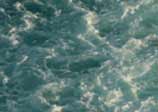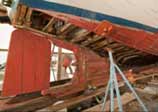For a complete understanding of the Catalina 22 and Catalina 25 swing keel pivot mechanism, start with the first article in this series: History of Retractable Keel Design.
For many years bronze castings were used which were flush with the inside of the keel trunk. The cast iron keels were sand cast in Mexico and varied substantially in thickness. This design left plenty of space for the keel to be fitted to the boat regardless of the keel’s exact thickness. This was fine other than a distinct “clunk” that could be heard from time to time while sailing. Inspection typically revealed no evidence of problems, so most sailors just accepted the noise as one of the nuances of sailing a retractable keel boat.
As boats passed their 15th birthday, we received more and more requests for replacement keel pins. The racers were the first to notice, not because they were harder on the boats, but they are the ones most likely to remove the keel and discover worn pivot pins. We have subsequently discovered that the boats most likely to have worn pivot pins (and keels) are those moored on a buoy or in an exposed marina. A boat rocking at its mooring 24 hours per day will experience more wear on the keel assembly than a racer is able to inflict. Boats moored in warm southern waters, especially Gulf Coast and Florida locations appear to be more susceptible to keel degradation than boats in other areas. This is probably due to accelerated electrolysis in addition to basic wear experienced in fresh water. Significant wear is not unusual. Luckily, the pivot pin is an inexpensive, relatively simple replacement. Unluckily, repairing a worn keel is not as easy.
If caught early, a small amount of wear to the keel can probably be ignored. If too much wear has occurred, the keel will have to be repaired. You have to judge if repair is necessary based on your visual inspection. Over the years several customers have reported keels lost due to the pivot holes wearing to the point the keel fell off the boat.
If repair to the keel is deemed necessary, the only solution is to remove the keel entirely. Take the keel to a machine shop and have the hole bored out. Some shops have a machine commonly refered to as a "mag drill" or portable magnetic drilling machine. These machines have a powerful electromagnet which clamps the machine directly to the keel when energized. There is no need to hoist your keel onto the table of the milling machine.
If there is plenty of material left for adequate strength, we have a stainless steel bushing available. It is 1.250” outside diameter (#D1908). I like the idea of having the machine shop prepare the hole so they can press the bushing into place. Epoxying the bushing in place may also be an option. The factory simply installs the bushing with a slip fit into the hole. Any of the three are probably fine.
If a larger bushing is necessary, the machine shop will be able to make it for you. Conceivably, a large bushing may have to be welded into place to rebuild some of the strength of the keel. Ask your machine shop for their recommendations.
It is important to note that we have repaired the symptom of the problem here, not the problem itself. To repair the problem, read the next article: Keel Casting Retrofit Eliminates Wear




